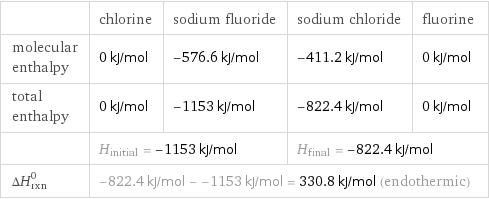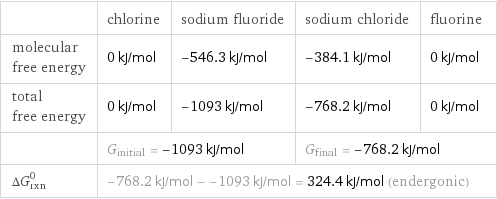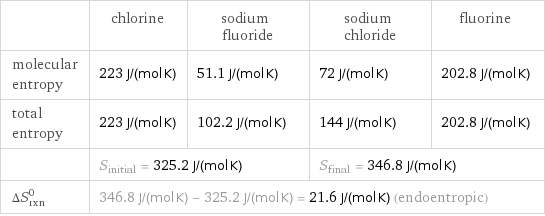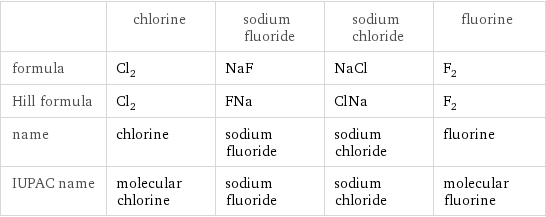Input interpretation

Cl_2 chlorine + NaF sodium fluoride ⟶ NaCl sodium chloride + F_2 fluorine
Balanced equation

Balance the chemical equation algebraically: Cl_2 + NaF ⟶ NaCl + F_2 Add stoichiometric coefficients, c_i, to the reactants and products: c_1 Cl_2 + c_2 NaF ⟶ c_3 NaCl + c_4 F_2 Set the number of atoms in the reactants equal to the number of atoms in the products for Cl, F and Na: Cl: | 2 c_1 = c_3 F: | c_2 = 2 c_4 Na: | c_2 = c_3 Since the coefficients are relative quantities and underdetermined, choose a coefficient to set arbitrarily. To keep the coefficients small, the arbitrary value is ordinarily one. For instance, set c_1 = 1 and solve the system of equations for the remaining coefficients: c_1 = 1 c_2 = 2 c_3 = 2 c_4 = 1 Substitute the coefficients into the chemical reaction to obtain the balanced equation: Answer: | | Cl_2 + 2 NaF ⟶ 2 NaCl + F_2
Structures

+ ⟶ +
Names

chlorine + sodium fluoride ⟶ sodium chloride + fluorine
Reaction thermodynamics
Enthalpy

| chlorine | sodium fluoride | sodium chloride | fluorine molecular enthalpy | 0 kJ/mol | -576.6 kJ/mol | -411.2 kJ/mol | 0 kJ/mol total enthalpy | 0 kJ/mol | -1153 kJ/mol | -822.4 kJ/mol | 0 kJ/mol | H_initial = -1153 kJ/mol | | H_final = -822.4 kJ/mol | ΔH_rxn^0 | -822.4 kJ/mol - -1153 kJ/mol = 330.8 kJ/mol (endothermic) | | |
Gibbs free energy

| chlorine | sodium fluoride | sodium chloride | fluorine molecular free energy | 0 kJ/mol | -546.3 kJ/mol | -384.1 kJ/mol | 0 kJ/mol total free energy | 0 kJ/mol | -1093 kJ/mol | -768.2 kJ/mol | 0 kJ/mol | G_initial = -1093 kJ/mol | | G_final = -768.2 kJ/mol | ΔG_rxn^0 | -768.2 kJ/mol - -1093 kJ/mol = 324.4 kJ/mol (endergonic) | | |
Entropy

| chlorine | sodium fluoride | sodium chloride | fluorine molecular entropy | 223 J/(mol K) | 51.1 J/(mol K) | 72 J/(mol K) | 202.8 J/(mol K) total entropy | 223 J/(mol K) | 102.2 J/(mol K) | 144 J/(mol K) | 202.8 J/(mol K) | S_initial = 325.2 J/(mol K) | | S_final = 346.8 J/(mol K) | ΔS_rxn^0 | 346.8 J/(mol K) - 325.2 J/(mol K) = 21.6 J/(mol K) (endoentropic) | | |
Equilibrium constant
![Construct the equilibrium constant, K, expression for: Cl_2 + NaF ⟶ NaCl + F_2 Plan: • Balance the chemical equation. • Determine the stoichiometric numbers. • Assemble the activity expression for each chemical species. • Use the activity expressions to build the equilibrium constant expression. Write the balanced chemical equation: Cl_2 + 2 NaF ⟶ 2 NaCl + F_2 Assign stoichiometric numbers, ν_i, using the stoichiometric coefficients, c_i, from the balanced chemical equation in the following manner: ν_i = -c_i for reactants and ν_i = c_i for products: chemical species | c_i | ν_i Cl_2 | 1 | -1 NaF | 2 | -2 NaCl | 2 | 2 F_2 | 1 | 1 Assemble the activity expressions accounting for the state of matter and ν_i: chemical species | c_i | ν_i | activity expression Cl_2 | 1 | -1 | ([Cl2])^(-1) NaF | 2 | -2 | ([NaF])^(-2) NaCl | 2 | 2 | ([NaCl])^2 F_2 | 1 | 1 | [F2] The equilibrium constant symbol in the concentration basis is: K_c Mulitply the activity expressions to arrive at the K_c expression: Answer: | | K_c = ([Cl2])^(-1) ([NaF])^(-2) ([NaCl])^2 [F2] = (([NaCl])^2 [F2])/([Cl2] ([NaF])^2)](../image_source/609e1ba25779d6dcdfc9067d8a19dfcc.png)
Construct the equilibrium constant, K, expression for: Cl_2 + NaF ⟶ NaCl + F_2 Plan: • Balance the chemical equation. • Determine the stoichiometric numbers. • Assemble the activity expression for each chemical species. • Use the activity expressions to build the equilibrium constant expression. Write the balanced chemical equation: Cl_2 + 2 NaF ⟶ 2 NaCl + F_2 Assign stoichiometric numbers, ν_i, using the stoichiometric coefficients, c_i, from the balanced chemical equation in the following manner: ν_i = -c_i for reactants and ν_i = c_i for products: chemical species | c_i | ν_i Cl_2 | 1 | -1 NaF | 2 | -2 NaCl | 2 | 2 F_2 | 1 | 1 Assemble the activity expressions accounting for the state of matter and ν_i: chemical species | c_i | ν_i | activity expression Cl_2 | 1 | -1 | ([Cl2])^(-1) NaF | 2 | -2 | ([NaF])^(-2) NaCl | 2 | 2 | ([NaCl])^2 F_2 | 1 | 1 | [F2] The equilibrium constant symbol in the concentration basis is: K_c Mulitply the activity expressions to arrive at the K_c expression: Answer: | | K_c = ([Cl2])^(-1) ([NaF])^(-2) ([NaCl])^2 [F2] = (([NaCl])^2 [F2])/([Cl2] ([NaF])^2)
Rate of reaction
![Construct the rate of reaction expression for: Cl_2 + NaF ⟶ NaCl + F_2 Plan: • Balance the chemical equation. • Determine the stoichiometric numbers. • Assemble the rate term for each chemical species. • Write the rate of reaction expression. Write the balanced chemical equation: Cl_2 + 2 NaF ⟶ 2 NaCl + F_2 Assign stoichiometric numbers, ν_i, using the stoichiometric coefficients, c_i, from the balanced chemical equation in the following manner: ν_i = -c_i for reactants and ν_i = c_i for products: chemical species | c_i | ν_i Cl_2 | 1 | -1 NaF | 2 | -2 NaCl | 2 | 2 F_2 | 1 | 1 The rate term for each chemical species, B_i, is 1/ν_i(Δ[B_i])/(Δt) where [B_i] is the amount concentration and t is time: chemical species | c_i | ν_i | rate term Cl_2 | 1 | -1 | -(Δ[Cl2])/(Δt) NaF | 2 | -2 | -1/2 (Δ[NaF])/(Δt) NaCl | 2 | 2 | 1/2 (Δ[NaCl])/(Δt) F_2 | 1 | 1 | (Δ[F2])/(Δt) (for infinitesimal rate of change, replace Δ with d) Set the rate terms equal to each other to arrive at the rate expression: Answer: | | rate = -(Δ[Cl2])/(Δt) = -1/2 (Δ[NaF])/(Δt) = 1/2 (Δ[NaCl])/(Δt) = (Δ[F2])/(Δt) (assuming constant volume and no accumulation of intermediates or side products)](../image_source/87c0ac756acd784a7e180f161c3cee54.png)
Construct the rate of reaction expression for: Cl_2 + NaF ⟶ NaCl + F_2 Plan: • Balance the chemical equation. • Determine the stoichiometric numbers. • Assemble the rate term for each chemical species. • Write the rate of reaction expression. Write the balanced chemical equation: Cl_2 + 2 NaF ⟶ 2 NaCl + F_2 Assign stoichiometric numbers, ν_i, using the stoichiometric coefficients, c_i, from the balanced chemical equation in the following manner: ν_i = -c_i for reactants and ν_i = c_i for products: chemical species | c_i | ν_i Cl_2 | 1 | -1 NaF | 2 | -2 NaCl | 2 | 2 F_2 | 1 | 1 The rate term for each chemical species, B_i, is 1/ν_i(Δ[B_i])/(Δt) where [B_i] is the amount concentration and t is time: chemical species | c_i | ν_i | rate term Cl_2 | 1 | -1 | -(Δ[Cl2])/(Δt) NaF | 2 | -2 | -1/2 (Δ[NaF])/(Δt) NaCl | 2 | 2 | 1/2 (Δ[NaCl])/(Δt) F_2 | 1 | 1 | (Δ[F2])/(Δt) (for infinitesimal rate of change, replace Δ with d) Set the rate terms equal to each other to arrive at the rate expression: Answer: | | rate = -(Δ[Cl2])/(Δt) = -1/2 (Δ[NaF])/(Δt) = 1/2 (Δ[NaCl])/(Δt) = (Δ[F2])/(Δt) (assuming constant volume and no accumulation of intermediates or side products)
Chemical names and formulas

| chlorine | sodium fluoride | sodium chloride | fluorine formula | Cl_2 | NaF | NaCl | F_2 Hill formula | Cl_2 | FNa | ClNa | F_2 name | chlorine | sodium fluoride | sodium chloride | fluorine IUPAC name | molecular chlorine | sodium fluoride | sodium chloride | molecular fluorine
Substance properties

| chlorine | sodium fluoride | sodium chloride | fluorine molar mass | 70.9 g/mol | 41.98817244 g/mol | 58.44 g/mol | 37.996806326 g/mol phase | gas (at STP) | solid (at STP) | solid (at STP) | gas (at STP) melting point | -101 °C | 993 °C | 801 °C | -219.6 °C boiling point | -34 °C | 1700 °C | 1413 °C | -188.12 °C density | 0.003214 g/cm^3 (at 0 °C) | 2.558 g/cm^3 | 2.16 g/cm^3 | 0.001696 g/cm^3 (at 0 °C) solubility in water | | | soluble | reacts dynamic viscosity | | 0.00105 Pa s (at 1160 °C) | | 2.344×10^-5 Pa s (at 25 °C) odor | | odorless | odorless |
Units
